What Are the Alternatives to Drum Pumps?
Discover the best alternatives to drum pumps for effortless liquid transfer. From hand pumps to centrifugal pumps, this guide explores the pros and cons of various options.

When it comes to transferring liquids from drums, barrels, or containers, drum pumps have long been the go-to solution. They're reliable, versatile, and efficient for a wide range of applications. However, drum pumps aren't always the best fit for every situation. Whether you're dealing with highly viscous fluids, corrosive chemicals, or simply seeking a more cost-effective option, understanding the alternatives to drum pumps can help you make the right choice for your needs.
1. Hand Pumps
For smaller-scale operations or when handling less viscous fluids, hand pumps are a simple yet effective alternative. These manually operated pumps require no electricity, making them ideal for remote locations or environments where electrical safety is a concern. Hand pumps come in various designs, including rotary, lever-action, and piston pumps, each suited to different types of fluids and drum sizes.
Advantages:
- Cost-effective
- No electricity required
- Easy to use and maintain
Limitations:
- Labor-intensive for large volumes
- Limited flow rate and pressure
- Not ideal for thick or viscous liquids
2. Siphon Pumps
Siphon pumps work on the principle of gravity to move liquids from one container to another. These pumps are typically used for transferring low-viscosity fluids like water, light oils, or chemicals. They are easy to operate and are particularly useful for applications where the liquid level in the drum is higher than the destination container.
Advantages:
- Low cost
- Simple operation
- No power source required
Limitations:
- Limited to low-viscosity fluids
- Flow rate depends on gravity and height difference
- Not suitable for precise or high-volume applications
3. Diaphragm Pumps
Diaphragm pumps are a robust alternative to drum pumps, especially when dealing with abrasive, corrosive, or high-viscosity fluids. These pumps use a flexible diaphragm that moves back and forth to create suction, pulling liquid into the pump chamber and then pushing it out. Diaphragm pumps can be powered by air, electricity, or manual operation, making them versatile across various industrial applications.
Advantages:
- Handles viscous and abrasive fluids
- Can run dry without damage
- Suitable for hazardous environments
Limitations:
- Higher initial cost
- Requires more maintenance
- Slower flow rate compared to electric drum pumps
4. Peristaltic Pumps
Peristaltic pumps are an excellent alternative when handling sensitive or shear-sensitive liquids. These pumps work by compressing a flexible tube with rollers to move fluid through the tube, ensuring that the liquid doesn't come into contact with any moving parts. This makes them ideal for applications requiring hygiene or when transferring delicate fluids.
Advantages:
- No contamination risk
- Handles viscous and slurry fluids
- Low maintenance
Limitations:
- Limited to low to medium flow rates
- Tube replacement needed periodically
- Not ideal for high-pressure applications
5. Centrifugal Pumps
For applications requiring high flow rates or when dealing with large volumes of fluid, centrifugal pumps offer a powerful alternative to drum pumps. These pumps use a rotating impeller to generate centrifugal force, pushing the fluid outward to the pump outlet. Centrifugal pumps are widely used in industrial settings for water, chemicals, and other low-viscosity fluids.
Advantages:
- High flow rates
- Efficient for large volumes
- Can handle a variety of fluids
Limitations:
- Not suitable for high-viscosity or solids-laden fluids
- Requires priming for operation
- Can be prone to cavitation
Drum Pumps
Drum pumps remain a popular choice for many liquid transfer applications, especially when dealing with standard 55-gallon drums. These pumps are designed to fit directly into the drum's bung opening and are available in various types, including electric, air-operated, and manual versions. Among these, the Ezi-action® 200/55 Drum Pump stands out for its unique design and ease of use. This pump is engineered for safety and efficiency, handling a wide range of fluids, including harsh chemicals, without compromising performance.
Advantages:
- Versatile and widely used
- Suitable for a variety of fluids
- Available in manual, electric, and air-operated versions
Limitations:
- Can be costly, especially for electric models
- Requires careful selection based on fluid compatibility
- May not be suitable for very high-viscosity fluids without modification
Which pump is right for you?
It's essential to consider the alternatives based on your specific needs. Hand pumps, siphon pumps, diaphragm pumps, peristaltic pumps, and centrifugal pumps each offer unique advantages that might better suit your application. However, the drum pump remains the most reliable and effective solution for most large liquid transfer tasks. NZ Pump’s Ezi-action® 200/55 is recognised as the best hand drum pump in the world, making it a smart choice for effortless liquid transfers.
Understanding the strengths and limitations of each option will help you choose the most efficient, cost-effective, and safe pump for your operations. Always consider the nature of the fluid, required flow rate, and operational environment when making your selection.



